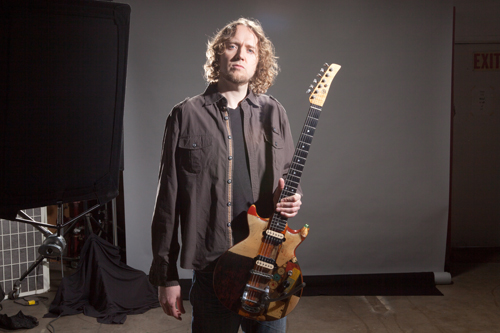 Playing music can often be related to the visual elements: stage lights, clothing and appearances, visual shapes of patterns on the guitar up and down the neck and reading guitar tablature and notation. However, any great guitarist and musician will tell you that it all comes down to having a well-trained ear. Recently, I had an opportunity to meet Robert Montgomery, Wes Montgomery’s son, who told me stories about how his dad didn’t read music and would learn extremely complex songs and note-for-note solos by ear. This kind of listening led him to understand the highest level of jazz harmony by relying on his hearing and formulating his own vocabulary. It can be said for many great studio guitarists that they can hear melodies, chord progressions and forms and play them back instantly. How can a guitarist progress and practice developing their ear?
Playing music can often be related to the visual elements: stage lights, clothing and appearances, visual shapes of patterns on the guitar up and down the neck and reading guitar tablature and notation. However, any great guitarist and musician will tell you that it all comes down to having a well-trained ear. Recently, I had an opportunity to meet Robert Montgomery, Wes Montgomery’s son, who told me stories about how his dad didn’t read music and would learn extremely complex songs and note-for-note solos by ear. This kind of listening led him to understand the highest level of jazz harmony by relying on his hearing and formulating his own vocabulary. It can be said for many great studio guitarists that they can hear melodies, chord progressions and forms and play them back instantly. How can a guitarist progress and practice developing their ear?
1) Sing what you play. One of the most important techniques is to allow notes to vibrate through you by singing them. If you are new to this, play a note on your guitar and then sing it back. Was it the exact note in the same register, or was it sharp or flat? Try to match precisely and, as you improve, eventually you can improvise anything on the guitar and match it with your voice. Often you can hear guitar greats doing this where they solo and sing with it. Once you have that mastered, try to harmonize with yourself—playing a scale on guitar and harmonizing it with your voice (for example, singing a third above).
2) Listen to the individual elements. When some people listen to music, it is just part of the background—they listen to the singer’s words and melody but the accompanying instruments are in the distance. There is so much more going on. First of all, there are five elements of music to be aware of: melody, harmony, rhythm, timbre and form. When you listen to music, be acutely aware of how these elements are used and combined. How is the melody shaped and contoured? What are the chord relationships and how do they evolve through time? What kinds of rhythms are being used by every instrument and do they contrast in different sections of the song? What is the timbre or quality of each instrument, the effects, natural tone and range and equalization that were used in the production? What is the form of the song from the beginning to the end and how many sections were there?
3) Practice ear-training exercises. Ear training exercises are essential for the developing musician. There are some great websites that feature a variety of theory related lessons and ear training interactive players. You should test yourself on the following topics: note intervals, chord qualities, rhythm dictation and melody dictation. Let’s talk about each independently.
• Interval ear training will help you hear and recognize the distances between notes, typically all 12 notes and their multiple spellings. This is particularly helpful when figuring out melodies. At a gig or studio session when an artist or producer plays a melody you need to be able to pick it up immediately without fumble.
• Chord qualities are hearing a type of chord, (typically four triads types and about 7 seventh chord types, built from any root). You should be able to identify the chord the first time, but in the beginning you may need to hear it several times or each note of the chord played separately.
• For rhythmic dictation you will probably have to do yourself if you have a way to record yourself. Record yourself clapping out a few rhythms—start slow with just one measure, but for more advanced training, do several measures—then write out the rhythm on a sheet of paper.
• Finally, for melodic dictation do the same thing, record notes in time and then listen back and write out your melody. Start with only a few notes in a short phrase but, after you improve on transcribing, try longer phrases of four measures or more.
4) Reading music that you’re not familiar with. This is just how it sounds: practice reading and understanding the notes on a page and how they turn into sound. Similarly to the previous lessons, it will get easier the more that you do it. Eventually all the musicality that we’ve talked about will come together and you will see the notes, intervals, and chords on the page and know how they sound before you play them.
5) Transcribing note-for-note. Everyone has his or her favorite players and musicians. If you’d like to like to learn from them the best way is to play along. Often you can write down the notes, chords and rhythms to understand them better, but listening, learning and playing along is good enough. Be careful to notice all the inflections, bends and ornaments. There may be great transcriptions and charts out there already but although it may take longer, and figuring it out on your own will make you internalize it more.
Think about great musicians with an incredible musical memory like Wes Montgomery, who had all the melodies and chords of a night stored in his mind, or Wolfgang Amadeus Mozart who could hear a full symphony and go home and write down what he heard. That musical memory is related to ear training and identifying in a deeper way how you process sound. Good luck, and happy listening.
For Alfred Music guitar books by Jared Meeker, click here.
By Jared Meeker
Sponsored by Alfred Music Publishing









